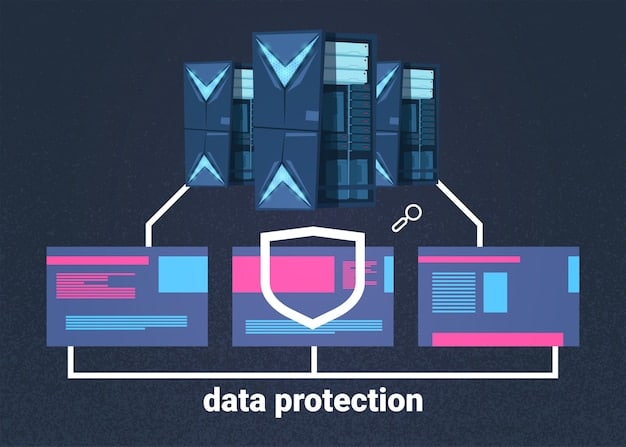Cybersecurity Stocks: The Ultimate Guide to Investing Smartly

Investing in cybersecurity stocks offers a strategic approach to fortifying your portfolio in an increasingly digital world, as these companies are at the forefront of protecting data and infrastructure from cyber threats.
In today’s digital age, where data breaches and cyberattacks are becoming increasingly common, investing in cybersecurity stocks presents a compelling opportunity. As businesses and individuals alike seek to protect themselves from online threats, companies specializing in cybersecurity solutions are experiencing rapid growth and demand. This guide explores the potential of cybersecurity stocks and how they can fortify your investment portfolio.
Why Invest in Cybersecurity Stocks?
The escalating frequency and sophistication of cyberattacks have made cybersecurity a top priority for businesses and governments worldwide. This surge in demand for robust security solutions is driving the growth of cybersecurity companies, making them attractive investment options. Explore the reasons why adding these stocks to your portfolio can be a strategic move.
Growing Demand and Market Size
The cybersecurity market is experiencing rapid expansion due to the increasing threats and the need for advanced protection. Investing in this sector allows you to tap into a market with high growth potential.
- Rising cyber threats: The constant evolution of cyber threats necessitates continuous investment in cybersecurity solutions.
- Digital transformation: As more businesses move their operations online, the need for cybersecurity becomes more critical.
- Regulatory compliance: Stringent data protection regulations are compelling organizations to invest in cybersecurity.
The growth of the cybersecurity market is not just a short-term trend but a long-term shift driven by the fundamental need to protect digital assets and infrastructure. This makes cybersecurity stocks a compelling investment for those looking to capitalize on secular growth trends.

Innovation and Technological Advancement
Cybersecurity companies are at the forefront of technological innovation, constantly developing new solutions to counteract emerging threats. Investing in these companies means supporting ongoing advancements in the field.
Cybersecurity firms dedicate significant resources to research and development, creating cutting-edge technologies that address the latest threats. Investing in these stocks means supporting the progress of vital security innovations.
The cybersecurity sector is continuously evolving, with new technologies like AI and machine learning being integrated to enhance threat detection and response. This constant innovation keeps cybersecurity companies at the forefront of technological advancement, which is a compelling reason to invest in the sector.
In conclusion, investing in cybersecurity stocks is driven by growing demand and continuous innovation. The increasing sophistication of cyber threats necessitates ongoing investment in advanced security solutions, making these stocks a promising addition to any investment portfolio.
Understanding the Cybersecurity Landscape
Before investing in cybersecurity stocks, it is vital to understand the different types of companies and the specific niches they occupy within the industry. This knowledge will help you make informed decisions and select investments that align with your risk tolerance and investment goals. Let’s delve into the various segments of the cybersecurity landscape.
Key Players in the Cybersecurity Market
The cybersecurity market is composed of diverse players, each specializing in different aspects of security. Identifying these key players and their areas of focus is essential for making informed investment decisions.
- Network security providers: Companies that offer solutions to protect networks from unauthorized access and cyber threats.
- Endpoint security specialists: Providers focusing on securing devices such as laptops, smartphones, and tablets.
- Data security companies: Firms that specialize in protecting data through encryption, access control, and data loss prevention.
Assessing Company Performance
Evaluating the financial health and performance of cybersecurity companies is crucial for making sound investment choices. Look at key metrics and indicators to assess their potential.
Analyzing revenue growth is one of the most important steps in evaluating cybersecurity companies. A company with consistent revenue growth is typically a sign of strong demand and effective market strategies. Other important factors include:
- Profit margins: Healthy profit margins indicate efficient operations and pricing strategies, increasing the likelihood of long-term success.
- Customer retention rates: High customer retention rates suggest that the company’s products and services are effective and valued by its customers.
- Research and development (R&D) spending: A strong commitment to R&D demonstrates that the company is dedicated to innovation and staying ahead of emerging threats.

Understanding the cybersecurity landscape involves identifying key players and evaluating company performance. The cybersecurity market is diverse, with companies specializing in various areas, from network security to threat intelligence. Consider the range of companies in investment.
Key Factors to Consider Before Investing
When investing in cybersecurity stocks, consider several key factors to ensure you are making informed decisions. These factors include understanding the company’s technology, its competitive position, and broader economic trends. By carefully evaluating these aspects, you can assess the potential risks and rewards associated with investing in cybersecurity stocks.
Company’s Technology and Innovation
Evaluate the uniqueness and effectiveness of a company’s technology. Look for evidence of innovation and the ability to adapt to emerging threats.
The strength of a company’s technology is a critical factor to consider. Does the technology offer real value and solve important problems for its customers? A company’s ability to innovate and stay ahead of emerging threats directly impacts its resilience and growth potential.
- Patent portfolio: A strong patent portfolio indicates that the company has unique technologies that competitors cannot easily replicate.
- Product reviews and ratings: Positive reviews and high ratings from customers and industry experts suggest that the technology is effective and well-regarded.
- Innovation pipeline: A robust pipeline of new products and features indicates that the company is committed to ongoing innovation.
Market Trends and Economic Conditions
Assess how broader market trends and economic conditions may impact the cybersecurity industry. Understand the implications of these external factors on your investment.
Market trends and economic conditions can significantly impact the cybersecurity industry. Consider global trade tensions, economic downturns, and interest rates, which can all influence investment decisions and the growth of cybersecurity companies. A broader economic downturn, for instance, might lead to cutbacks in IT spending, affecting the revenue of cybersecurity firms.
Before investing in cybersecurity stocks, carefully consider the company’s technology, its competitive position, and broader economic trends. By evaluating these factors, you can make more informed decisions and manage the risks associated with investing in this dynamic sector.
Building a Diversified Cybersecurity Portfolio
Diversification is a key strategy for managing risk in any investment portfolio, including one focused on cybersecurity stocks. Creating a diversified portfolio within the cybersecurity sector can help mitigate potential losses from individual stock performance while still capitalizing on the overall growth of the industry. Explore the importance of diversification and strategies for building a well-rounded cybersecurity portfolio.
Investing in Different Segments
Spread your investments across various segments within the cybersecurity industry. This will help you capture growth opportunities in different areas.
Different segments of the cybersecurity industry offer varying growth potentials and risk profiles. Spreading investments across multiple segments can help reduce your overall risk. For example, you might allocate funds to companies specializing in network security, endpoint protection, and identity management. This approach ensures that your portfolio is not overly dependent on the success of any single area.
Balancing Risk and Return
Optimize your portfolio by balancing high-growth, high-risk stocks with more stable, established companies. Assess the risk tolerance and investment horizon to make informed decisions.
Balancing risk and return is crucial for long-term investment success. High-growth stocks can offer substantial returns but also come with higher volatility. Including more established companies in your portfolio can provide stability and consistent returns, reducing overall risk. Assess your personal risk tolerance and investment timeline to strike the right balance for your cybersecurity portfolio.
- Blue-chip cybersecurity stocks: Consider including well-established companies with a history of consistent performance.
- Emerging cybersecurity stocks: Allocate a portion of your portfolio to smaller, high-growth companies with innovative technologies.
- Rebalancing: Periodically rebalance your portfolio to maintain your desired asset allocation and risk profile.
Building a diversified cybersecurity portfolio involves investing in different segments and balancing risk and return. The cybersecurity sector is dynamic, and diversification can help mitigate risks while capitalizing on growth. Balancing these factors will enhance your ability to achieve long-term financial goals.
Common Mistakes to Avoid When Investing
When investing in cybersecurity stocks, avoiding common pitfalls is essential for protecting your capital and maximizing potential returns. These mistakes range from overlooking key financial metrics to chasing hype. By being aware of these errors, you can make more informed investment decisions.
Ignoring Financial Metrics
Failing to assess key financial indicators such as revenue growth, profit margins, and debt levels can lead to poor investment choices. Financial metrics provide insights into a company’s performance and sustainability.
Financial metrics are essential tools for assessing the health and potential of a company. Ignoring these metrics can be detrimental to your investment decisions. Look beyond the hype and evaluate key indicators such as revenue growth, profit margins, and debt levels.
- Revenue growth: Indicates the rate at which a company is increasing its sales.
- Profit margins: Show the profitability of a company’s operations.
- Debt levels: Highlight the company’s financial obligations and risk of insolvency.
Chasing Hype and Overvaluing Stocks
Investing based on media buzz or inflated valuations can lead to significant losses. It is important to conduct thorough research and avoid speculative investments.
Chasing hype and overvaluing stocks are common mistakes that can lead to substantial losses, as excitement is often fleeting. Consider what makes the company stand out in this highly competitive sector, and ask fundamental questions like: does it make profits? A high valuation alone does not guarantee future success, making it essential to conduct thorough research and exercise caution when investing based on market sentiment.
To avoid common mistakes when investing in cybersecurity stocks, focus on sound financial analysis and avoid chasing hype. Thorough research, due diligence, and a long-term perspective are key to making wise investment decisions in the cybersecurity market.
Future Trends in Cybersecurity and Investment Opportunities
The cybersecurity landscape is constantly evolving, making it essential to stay informed about emerging trends and their potential impact on investment opportunities. New technologies and evolving threats create opportunities for growth and innovation. Understanding these future trends can help you position your portfolio for long-term success. Let’s explore some of the key upcoming areas in cybersecurity.
Artificial Intelligence and Machine Learning
AI and machine learning are revolutionizing cybersecurity by providing advanced threat detection, automated incident response, and predictive analytics. Investing in companies that leverage these technologies is a promising opportunity.
Artificial intelligence (AI) and machine learning (ML) are transforming cybersecurity. These technologies enable advanced threat detection, automated incident response, and predictive analytics. As cyber threats become more sophisticated, AI and ML will play an increasingly important role in defending against them.
Cloud Security Solutions
With the increasing adoption of cloud computing, the demand for robust cloud security solutions is rising. Investing in companies specializing in cloud security is a strategic move.
The increasing adoption of cloud computing has created a significant demand for specialized security solutions. Investing in companies offering cloud security services can be a strategic move to capitalize on this growing market. As more businesses move their data and operations to the cloud, the need for robust security measures will continue to rise.
Future trends in cybersecurity, such as AI, ML, and cloud security, present exciting investment opportunities. By staying informed and positioning your portfolio to capitalize on these trends, you can achieve long-term success in the cybersecurity market. Consider the trends when investing in cybersecurity stocks for your portfolio.
| Key Point | Brief Description |
|---|---|
| 🛡️ Market Growth | Cybersecurity market is rapidly expanding due to rising cyber threats. |
| 🔬 Tech Innovation | Companies are continuously developing advanced security solutions. |
| 💼 Diversification | Spread investments across different cybersecurity segments. |
Frequently Asked Questions
Cybersecurity is a rapidly growing industry driven by increasing cyber threats and digital transformation. Investing in cybersecurity stocks allows you to capitalize on this growth while helping protect businesses and individuals from online attacks.
Key segments include network security, endpoint security, data security, cloud security, and threat intelligence. Diversifying your investments across these segments can help manage risk and capture opportunities across the sector.
Evaluate key financial metrics such as revenue growth, profit margins, customer retention rates, and research and development spending. These indicators provide insights into the company’s performance and sustainability.
Avoid ignoring financial metrics, chasing hype, and overvaluing stocks. Conduct thorough research, exercise due diligence, and focus on long-term growth potential rather than short-term market sentiment.
Keep an eye on trends like artificial intelligence, machine learning, cloud security, and the evolving threat landscape. These areas are driving innovation and creating new investment opportunities in cybersecurity.
Conclusion
Investing in cybersecurity stocks offers a unique opportunity to capitalize on the growing need for digital protection in an increasingly interconnected world. While it requires careful research and a keen understanding of market dynamics, the potential rewards of securing your portfolio with these innovative companies can be substantial. By following the guidelines outlined in this guide, you can make informed decisions and navigate the cybersecurity investment landscape with confidence.





